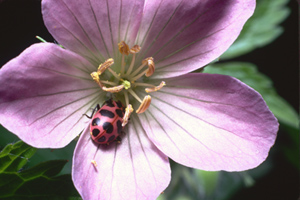|
||
      |
Flower power
A seasoned botanist explains how flowering plants aided Earth’s evolution.

Burger captured a beetle visiting a wild geranium, exhibiting all-important
pollination.
At the academic year’s first Divinity School Wednesday lunch, Field Museum botanist William C. Burger wowed the late-September group with heroic tales of flowers. Yes, said the animated, white-bearded curator emeritus in the Field’s Department of Botany, flowering plants have altered the entire planet—as he titled his book, Flowers: How They Changed the World (Promethius Books, 2006). Without nice-looking and -smelling flowers as advertisements, insects wouldn’t be attracted to and pollinate them, creating the wide array of plants that make up, say, rainforests. “Insect pollination,” Burger said, “allowed vegetation to become far more diverse.”
To identify flowering plants, Burger advised, “forget flowers.” Because the “purpose of flowers is sex,” he said, the defining structures are the male sex organ, the stamen, and the female organ, the pistil. Flowering plants include not only geraniums, roses, and lilies but also avocados—“the richest fleshy fruit in the plant world”—and wind-pollinated grass, whose florets hide inside protective, leaf-like bracts.
Besides producing diverse vegetation, flowers also changed the world by promoting primate evolution, Burger said. Originally insectivores, primates climbed trees to eat bugs gathered near the fruits and flowers, growing long arms to reach their prey. Over time, as monkeys began eating fruit, they developed bending wrists and fingers to examine the food. Their eyes moved forward to enhance three-dimensional vision as they jumped from tree to tree. The resulting flatter face meant primates could no longer see behind them to ward off predators, so they lived in small groups and looked after each other.
Grass had a hand in evolution too, helping to lure primates out of the forest. First appearing 25 million years ago in South America, grasslands expanded as the earth dried and cooled. Eventually, Burger said, summarizing millions of years in a sentence, “one of the apes got up on its hind feet and moved to the savannah,” where herbivores grazed. Here primates found meat. Eating meat literally beefed up mother’s milk with proteins and nutrients that helped infant brains grow bigger. So grasslands, he said, “allowed us to become who we are.”
Later on, between 9,000 and 10,000 years ago in different parts of the world, flowering plants helped humans establish agriculture. “Thanks to a few animals and more flowering plants,” Burger said, societies grew rice, wheat, barley, maize, legumes. Because people could store these foods, “we were able to build great civilizations” and become “masters of the planet.”
Humans haven’t been the kindest masters, however, and Burger warned of hazards to flowers and the rest of the earth. “There are 6 billion people on the planet, and no one’s talking about pulling the brakes.” Such overpopulation, he writes in Flowers, strains water resources, agricultural soil, urban environments, and already-declining fisheries. More than half the human population is malnourished. “Clearly, human beings are not living in sustainable harmony with the biosphere that supports them.”
What can an ordinary citizen do to help? one listener wanted to know. “Reduce your impact,” Burger said. “Utilize less energy, drive cars less. Our modern lifestyle has given us the richest life anyone has ever had, and no one wants to give that up.”
Another luncher asked Burger to name his favorite flower. “I don’t have a favorite,” he responded, adding that as an amateur photographer he enjoys visiting Chicagoland’s remnant prairies, such as west-suburban Wolf Road Prairie. “If you go out there from May to even now,” he said, “every few weeks there is a new set of characters dancing in the landscape.” All, it seems, his favorites.